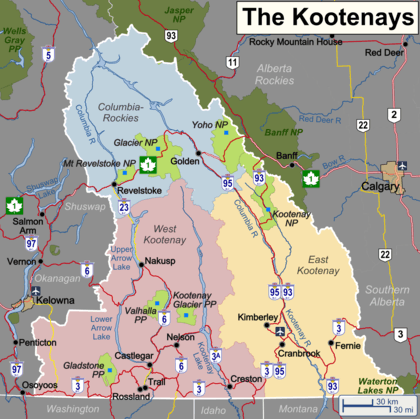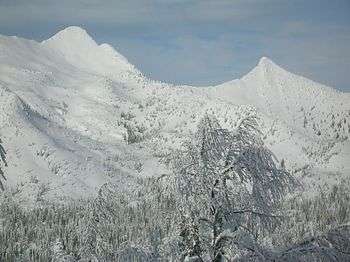Kootenays
Kootenays is a large region in British Columbia, Canada. This area begins at the Alberta Border and extends west to the Monashee range of the Columbia Mountains. The area is famed for its laid-back lifestyle and endless outdoor adventure opportunities.
Regions

| Columbia-Rockies From Revelstoke to the Alberta border along the Trans-Canada Highway. |
| East Kootenays Ski resorts and natural hot springs. |
| West Kootenays Home of retired hippies and the eccentric Doukhabors. |
Cities
- 🌍 Cranbrook - the Kootenays' largest city. - almost 30,000 people
- 🌍 Nelson - "The Queen City" of the Kootenays, renowned for its tourism, culture and outdoor activities. - 10,508 people
- 🌍 Revelstoke - summer and winter mountain playground. - 7,500 people
- 🌍 Golden - gateway to the Rockies. - 3,800 people
- 🌍 Castlegar - Russian links provided by the Doukhobor sect and a Russian Orthodox chapel. - 8,612 people
- 🌍 Trail - home of one of the worlds largest operational zinc smelters. - 7,336 people
- 🌍 Fernie - world-renowned kayaking, mountain-biking, and skiing. - 5,278 people
- 🌍 Rossland - produced gold mines and gold-medal skiers. - 4,200 people
- 🌍 Creston - a vast plain in otherwise mountainous country. - 5,100 people
- 🌍 Kimberley - quaint European styled chalet village. - 7,300 people
Other destinations
- 🌍 Glacier National Park - home of Rogers Pass.
- Gladstone Provincial Park - camping on Christina Lake.
- 🌍 Kokanee Glacier Provincial Park - it still has a glacier and has great hiking in summer and awesome skiing in winter.
- 🌍 Kootenay National Park
- 🌍 Mount Assiniboine Provincial Park
- 🌍 Mount Revelstoke National Park - alpine meadows.
- Valhalla Provincial Park - you don't have to be a Viking to know this is heaven.
- 🌍 Yoho National Park - explore the scenic beauty of Canada's second National Park.
Understand

The name is derived from the Ktunaxa First Nation's quthni, meaning "to travel by water", and indeed this is how the region was explored before the railway arrived. Exploration by river and lake, and commerce facilitated by the large sternwheelers that plied the many large lakes emphasize this point. Virtually untouched until the gold and silver rushes of the mid-1800s, a few settlers who fell in love with the area remained after the fortunes faded, and provided the roots for the communities as they exist today.
In the early days of British Columbia the Kootenays were geographically isolated from the rest of the province. The Canadian Pacific Railway built the Kettle Valley Railway to link the area to Vancouver, and also to waylay any plans of US annexation, an area the Kootenays had stronger physical ties to at the time. The Crowsnest Highway which bisects the region was completed in 1949, further solidifying the link to the rest of the province.
The Kootenays are comprised of several roughly north-south mountain ranges and the valleys between. From east to west there are the Rocky Mountains, Purcell Mountains, and the Selkirk and Monashee ranges of the Columbia Mountains. There are also several very large lakes in this area, the largest of which were formed by hydroelectric dams. Lake Koocanusa, which gets its clever name for the fact it stretches across the international border, was formed by the Libby Dam in Idaho. Kootenay Lake which is about 100 km long with a 35-km western extension to the town of Nelson is a natural lake, though the southern floodplains were diked to reclaim agricultural land. Arrow Lake, (which is divided into north and south portions at the Needles-Fauquier ferry) is almost 200 km long, stretching from Revelstoke to Castlegar. It was formed by the Keenlyside Dam.
Today, this area is comprised of many small towns, and as with most of British Columbia, this area favors travellers looking for natural beauty and outdoor adventure, rather than cosmopolitan cities. It is particularly renowned for alpine skiing, due to the large amounts of snow the area receives, with several large lift-accessed resorts and a booming cat skiing industry.
The climate is generally warm and sunny in the summer, and cold and snowy in the winter. Winter driving conditions can be treacherous at times, so do take caution.
Talk
The de facto language in this area is English. It might be possible to get official services in French. Signage is bilingual in national parks.
Get in
There are only two major airports serving the area, Castlegar in the west and Cranbrook/Canadian Rockies International Airport in the east. Castlegar only serves to Vancouver and Calgary on Air Canada Express, and Cranbrook serves to Vancouver and Calgary on Pacific Coastal Airlines, Air Canada Express, and Salt Lake City on Delta Air Lines. The other major airports that people use to get in and out of the area are Spokane in Washington, and Calgary in Alberta.
Get around
The only practical method for touring this area is by road. Car rentals will be available in all major cities. The area is served by an extensive highway network. The Crowsnest Highway (3) is the major east-west route, traversing the area from the Alberta border to the Okanagan. Highway 6 links the area to the North Okanagan in Vernon, and the Trans-Canada Highway passes through this area from Revelstoke to the Alberta border. North-south routes include Highway 23 which links Revelstoke to Highway 6 in Nakusp, and Highway 95 which links Golden to Cranbrook, and the US border farther south.
|
Greyhound Canada Greyhound Canada terminated all services in Western Canada and Northern Ontario effective October 31, 2018. |
See
- Rogers Pass between Revelstoke and Golden is not to be missed. It receives an incredible ten meters of snow each winter.
- A visit to one of the many Hydroelectric Dams in the area can be fascinating and educational.
- A darker side of Canada's history is examined at the Nikkei Internment Memorial Centre, which preserves the stories of the more than 20,000 Japanese-Canadians interned here during the second World War.
- Fort Steele is preserved as an 1890s pioneer boomtown. Just north of Cranbrook.
- The Le Roi Gold Mine and Rossland Museum tell the story of the Kootenay gold rush.
- The Burgess Shale Fossils, Yoho National Park. A UNESCO World Heritage Site that showcases the world's finest Cambrian-aged fossils of soft-bodied marine organisms.
Do
- Go skiing or snowboarding at Whitewater (Nelson), Red Mountain (Rossland), Fernie Alpine, Kimberly Alpine, Panorama (Invermere), Fairmont, (Fairmont Hot Springs), Kicking Horse, (Golden), or Powder Springs (Revelstoke).
- The area's many provincial and national parks provide no end of opportunities for outdoor enthusiasts. Hiking, mountain biking, and fishing are all popular pastimes in this region.
- Snowmobiling is a popular winter recreation, especially in the Revelstoke area, where competitions and hill-climbs are organized.
Eat
As with most areas in Canada, there is no real specialty or localized cuisine. It is possible to find food from almost any ethnic background in most communities.
Drink
One of Canada's favourite beers Kokanee is brewed exclusivly in Creston. It would be remiss to visit the area and not try a bottle. There are tours of the brewery available as well. The City of Nelson has its own brewery, the Nelson Brewing Company.)
Stay safe
- When skiing or hiking in the backcountry there is always a danger of avalanches. The Canadian Avalanche Association has advisories for this region on their website.
Go next
- There are nine international border crossings in this region between Canada and the United States. Not all are open 24 hours, enquire locally. In some cases, the busiest crossings are closed overnight, and a less-used one is open 24 hours so that motorists won't have to detour by more than one border crossing location.
- The sun and fun of the Okanagan is due west.